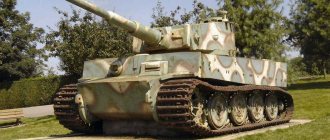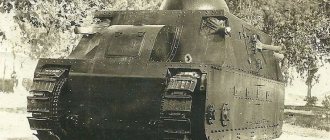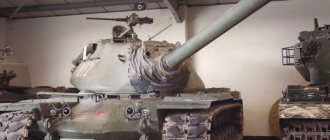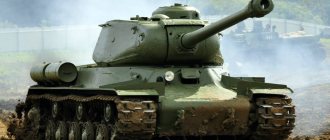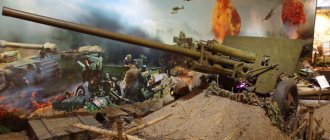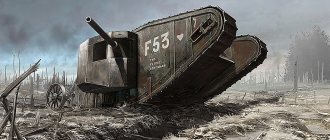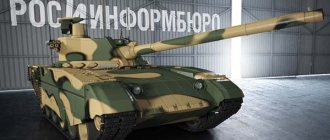The idea that German tanks of World War 2 were all “Tigers” and “Panthers” was firmly established in the public consciousness. In fact, these heavy combat vehicles appeared in Nazi Germany only in 1943. The German tanks of World War II, on which the Wehrmacht began this global military adventure, were far from being as powerful and armored.
In 1939-1941. and the Germans’ artillery was still almost all horse-drawn, and the Wehrmacht did not have many tanks - more than 3 times less than the Red Army. The reason for Germany's military successes was not in quantity, but in quality - tanks were used extremely skillfully and competently.
German tanks of World War II at the beginning of the invasion of the USSR
Wehrmacht tanks were supposed to become the “wild card” in the war with the Soviet Union, playing a decisive role in the blitzkrieg - “lightning war”. In accordance with this strategy, Nazi Germany formed its armored power.
Light German tanks of World War 2
1. The Pz.Kpfw.I (T-I) tank was produced from 1933 to 1938; and for another three years after that, its tracked chassis was produced only as command and reconnaissance vehicles (without turrets), as well as as a basis for self-propelled artillery units.
T-I
These light tanks did not have guns: only 2 twin 7.92 mm machine guns mounted in a common mantlet. In total, in 1933-1938. 1867 Pz.Kpfw.I tanks were produced.
Pz.Kpfw – this means Panzerkampfwagen – “armored fighting vehicle” translated from German. 2.Pz.Kpfw.II (T-II), jointly produced by MAN and Daimler-Benz, was produced from 1937 to 1942, in five modifications: from A to F. The armament of most of them consisted of a 20-mm gun and a coaxial 7.62 mm machine gun.
T-II
Part of the Pz.Kpfw.II was flamethrower, with two flamethrowers firing at 50 m. Self-propelled artillery mounts, artillery tractors, and ammunition carriers were made on this chassis. In total, over the years of production, 3,500 T-II chassis were made, of which 2,050 were tanks.
3. Pz.Kpfw.II Luchs (T-II Luchs), also from MAN and Daimler-Benz - a special reconnaissance tank with a two-seat rather than a single turret (like a regular Pz.Kpfw.II).
T-II Lux
These German WWII tanks were produced in 1942-1944; Exactly 100 of them were made.
Medium tanks of the Wehrmacht of World War II 1939 1945
3. PzKpfw III (T-III) developed by Daimler-Benz since 1937 entered service with tank units of the Wehrmacht and Waffen SS. The tank was produced in the following modifications: with a 37 mm gun; with a 50 mm gun; with a 75 mm howitzer; with a flamethrower; command vehicle; and a reconnaissance and observation vehicle.
T-III
In addition to the cannon, the PzKpfw III was also equipped with 2 or 3 7.92 mm MG-34 machine guns. Over the years of production (1936-1943), this Wehrmacht armored vehicle was produced in the amount of 6,166 units.
4. PzKpfw IV (T-IV) . These Wehrmacht tanks 1941-1945 are the most popular in Germany: 8,588 of them were produced. This model, developed and produced by Krupp, was produced from 1937 to 1945.
T-IV
T-IV tanks were equipped with 75 mm guns of various modifications and lengths, as well as one or two 7.92 mm machine guns. Due to the regular increase in armor thickness, the weight of armored vehicles produced during production increased from 17 tons to 24.6 tons. PzKpfw IV is the most widely represented German World War II tank in museums around the world.
Wehrmacht organization
- High Command of the German Armed Forces - OKW;
The branches of the military are headed by the corresponding high commands:
- Supreme Command of the Ground Forces - OKH;
- Supreme Command of the Navy - OKM;
- High Command of the Air Force (Luftwaffe) - OKL.
The Supreme Commander of the Wehrmacht was Reich Chancellor Adolf Hitler. The Supreme Command is headed by the commander-in-chief of the corresponding branch of the armed forces. Each branch of the army had its own commander-in-chief, chief of staff and staff, who were subordinate to the chief of staff of the operational leadership of the Wehrmacht, and he, in turn, to the chief of staff of the headquarters, headed by Hitler as the supreme commander-in-chief.
Organizational structure of the Wehrmacht High Command (OKW)
- Supreme Commander: Fuhrer and Chancellor
- Commander of the Ground Forces
- Commander of the Navy
- Commander of the Air Force
1938 - 1941
- Supreme Commander and Minister of War: Fuhrer and Chancellor
- Commander-in-Chief of the Armed Forces
- Commander of the Ground Forces
- Commander of the Navy
- Commander of the Air Force
1941 - 1945
- Supreme Commander, Minister of War and Commander-in-Chief of the Army: Führer and Chancellor
- Chief of Staff of the Ground Forces
- Commander-in-Chief of the Armed Forces
- Commander of the Navy
- Commander of the Air Force
Wehrmacht tanks of World War II, put into production during the war with the USSR
The experience of the wars with the Soviet Union has shown that the firepower and armor protection power of German tanks is not enough. What worked great in Europe turned out to be ineffective for Soviet realities. The Soviet T-34s were superior to all Wehrmacht tanks, so the next model of the German medium tank, the PzKpfw V Panther (T-V Panther) , was developed “with an eye on the T-34.” First of all, this concerns a more rational hull shape, to a certain extent borrowed from Soviet tanks.
PzKpfw V Panther tanks developed by Daimler-Benz were produced in 1943-1945. They were armed with powerful long-barreled 75 mm guns. A 7.92-mm MG 34 machine gun was paired with the cannon, and the second machine gun was placed in the front plate of the hull, in a yoke mount.
T-V "Panther"
The Panther tanks of modifications A and G also had “close combat devices” in the right rear part of the turret roof - mini-mortars (grenade launchers) that fired smoke, fragmentation and incendiary grenades. Before the end of the war, the Germans managed to produce about 6 thousand PzKpfw V tanks. In the USSR, the Panther medium tanks were considered heavy (combat weight 44.8 tons versus 26.5 tons - 30.9 tons for the T-34 of various modifications).
Is the difference noticeable?
But at first we were lied to (or kept silent) for political reasons by specialists from GLAVPUR, who were not ordered by the party bosses to talk about the contribution of Poland, the Czech Republic, Slovakia and other countries of the Warsaw Pact and the socialist camp to the war on the side of the Reich, because it was not comme il faut, also under France and Finland (as trading partners who did not join NATO) were automatically banned from reporting such stories. No, we knew very well about the Polish Army, but much worse - about the fact that Poland was the hyena of Europe and about the Home Army - they also didn’t tell us, Bogomolov’s book therefore caused a shock, we knew about the Normandy-Niemen squadron and didn’t know about French Legion and Charlemagne Division. They knew about Nalepka and his partisans, but they were not aware of the Slovak aviation and the Slovak division that died at Stalingrad, where Nalepka actually came from. Well, they are our allies, they are also socialist progressive countries! The fact that before this they were reliable allies of the Wehrmacht was not emphasized.
And now it’s coming back to haunt me. The Europeans are preparing a mess for us again - the time is coming, the visits of the Western community to us in military style used to happen a couple of times every hundred years, but after the defeat of the next visit, this public was so scared that it sat quietly for seventy years. But all good things come to an end, now Europe’s hostility towards our country is visible quite clearly, and the fifth column, traditionally represented by liberals, lies like hired ones. I don’t like Glavpur, but modern liars are much nastier.
This lie was started by Vitya Rezun, who said that the USSR had 24 thousand tanks, but the Germans didn’t even have 4 thousand.
I can't resist posting a few not too famous photos. They feature captured Soviet tanks. The same ones - from 24 thousand formidable machines. There’s just one caveat: these boxes were intended to be installed as BOTs. They managed to install this 'death machine'.
And these remained standing on the outskirts. No engines, no tracks. With equipment removed, unable to move, with weapons, often worn out and incomplete. But they are also carefully calculated by our 'objectivists'.
This topic was further developed. Mukhin was perhaps the first to mention the 5 thousand captured French and 400 British tanks and armored vehicles of the expeditionary force. This caused the “enlightened objectivists,” as the admirers of the Reich call themselves, to scream with rage.
The main objections can be stated as follows:
- It is common knowledge that Mukhin is crazy.
- It is well known that the Germans did not like the design and layout of French tanks at all.
- Therefore, the Germans used them in extremely small quantities. Here, for confirmation, Müller-Hillebrandt, who knows how to keep silent about unpleasant things better than our Glavpur generals, is attracted by the ears.
However, upon closer (albeit rather superficial) study of the material, it turned out that all of the above is a lie. Let’s leave aside the statement about Mukhin’s madness, because even if he is crazy, the fact that ALL the weapons of ALL France (and this is technically the best army in Europe) and the entire industry producing these weapons fell into German hands remains. The number of Frankish pieces of iron also turns out to be appropriate.
Panzerkampfwagen VI Tiger
The Tiger project was developed in 1941, and already in August 1942 the first copies took part in the battle of Leningrad, and then in the battle of Kursk. After German troops attacked the Soviet Union and met serious resistance in the form of the maneuverable armored T-35, whose gun could damage any German tank, it was decided to create a vehicle capable of repulsing it. Therefore, the engineers were faced with the task of creating a modernized analogue of the KV-1 using PzKpfw IV technology.
Excellent armor and an 88-mm cannon made the tank the best among heavy tanks around the world, which was recognized by the US, British and French troops. The powerful armor of the tank on all sides made it practically invincible, but such new weapons caused the anti-Hitler coalition to need new means of combat. Therefore, towards the end of the war, Germany’s opponents had self-propelled guns that were capable of destroying the German Tiger tank. These included the Soviet SU-100 and ISU-152.
Panzerkampfwagen VIII Maus
The Wehrmacht planned to build a super-heavy tank that would become an elusive target for enemy equipment. After Hitler had already signed an order for development, leading machine builders convinced him that there was no need to create such a model. But Ferdinand Porsche thought differently and therefore personally began designing the configuration of a new super-heavy piece of military equipment. As a result, the “Mouse” was created, the armor of which is 200-240 mm, which is a record for military equipment.
Only 2 copies saw the light of day, but they were blown up by the Red Army in 1945, like many other German tanks. The photographs that survive and the model assembled from the two aforementioned blown up tanks give a great idea of how powerful this model was.


